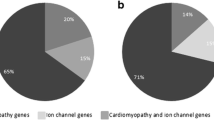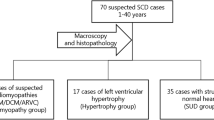Abstract
Background
Acute thoracic aortic dissections and ruptures, the main life-threatening complications of the corresponding aneurysms, are an important cause of sudden cardiac death. Despite the usefulness of the molecular diagnosis of these conditions in the clinical setting, the corresponding forensic field remains largely unexplored. The main goal of this study was to explore and validate a new massive parallel sequencing candidate gene assay as a diagnostic tool for acute thoracic aortic dissection autopsy cases.
Materials and methods
Massive parallel sequencing of 22 thoracic aortic disease candidate genes performed in 17 cases of thoracic aortic dissection using AmpliSeq and Ion Proton technologies. Genetic variants were filtered by location, type, and frequency at the Exome Aggregation Consortium and an internal database and further classified based on the American College of Medical Genetics and Genomics (ACMG) recommendations published in 2015. All prioritized results were confirmed by traditional sequencing.
Results
From the total of 10 potentially pathogenic genetic variants identified in 7 out of the 17 initial samples, 2 of them were further classified as pathogenic, 2 as likely pathogenic, 1 as possibly benign, and the remaining 5 as variants of uncertain significance, reaching a molecular autopsy yield of 23%, approximately.
Conclusions
This massive parallel sequencing candidate gene approach proved useful for the molecular autopsy of aortic dissection sudden cardiac death cases and should therefore be progressively incorporated into the forensic field, being especially beneficial for the anticipated diagnosis and risk stratification of any other family member at risk of developing the same condition.
Similar content being viewed by others
References
Montagnana M, Lippi G, Franchini M, Banfi G, Guidi G (2008) Sudden cardiac death in young athletes. Intern Med 47(15):1373–1378
Ripperger T, Tröger H, Schmidtke J (2009) The genetic message of a sudden, unexpected death due to thoracic aortic dissection. Forensic Sci Int 187(1–3):1–5. doi:10.1016/j.forsciint.2009.01.020
Kuzmik G, Sang A, Elefteriades J (2012) Natural history of thoracic aortic aneurysms. J Vasc Surg 56(2):565–571. doi:10.1016/j.jvs.2012.04.053
Prakash S, Kuang S, Investigators GTACR, Regalado E, Guo D, Milewicz D (2016) Recurrent rare genomic copy number variants and bicuspid aortic valve are enriched in early onset thoracic aortic aneurysms and dissections. PLoS One 11(4):e0153543. doi:10.1371/journal.pone.0153543
Elefteriades J (2008) Thoracic aortic aneurysm: reading the enemy’s playbook. Yale J Biol Med 81(4):175–186
Pannu H, Tran-Fadulu V, Milewicz D (2005) Genetic basis of thoracic aortic aneurysms and aortic dissections. Am Mournal Med Genet Part C 139C(1):10–16. doi:10.1002/ajmg.c.30069
Erbel R, Aboyans V, Boileau C, Bossone E, Di Bartolomeo R, Eggebrecht H et al (2014) ESC guidelines on the diagnosis and treatment of aortic diseases. Eur Heart J 35(41):2873–2926. doi:10.1093/eurheartj/ehu281
Milewicz DM, Guo D-C, Tran-Fadulu V, Lafont AL, Papke CL, Inamoto S et al (2008) Genetic basis of thoracic aortic aneurysms and dissections: focus on smooth muscle cell contractile dysfunction. Annu Rev Genomics Hum Genet 9:283–302. doi:10.1146/annurev.genom.8.080706.092303
Cannon Albright L, Camp N, Farnham J, MacDonald J, Abtin K, Rowe KG (2003) A genealogical assessment of heritable predisposition to aneurysms. J Neurosurg 99(4):637–643. doi:10.3171/jns.2003.99.4.0637
Isselbacher E (2005) Thoracic and abdominal aortic aneurysms. Circulation 111(6):816–828. doi:10.1161/01.CIR.0000154569.08857.7A
Li Y, Li L, Mu H, Fan S, He F, Wang Z (2015) Aortic dissection and sudden unexpected deaths: a retrospective study of 31 forensic autopsy cases. J Forensic Sci 60(5):1206–1211. doi:10.1111/1556-4029.12768
Bisleri G, Bagozzi L, Muneretto C (2013) Current evidence and insights about genetics in thoracic aorta disease. Sci World J 2013:e962097. doi:10.1155/2013/962097
Coady MA, Davies RR, Roberts M, Goldstein LJ, Rogalski MJ, Rizzo JA et al (1999) Familial patterns of thoracic aortic aneurysms. Arch Surg 134(4):361–367
Poninska J, Bilinska Z, Franaszczyk M, Michalak E, Rydzanicz M, Szpakowski E et al (2016) Next-generation sequencing for diagnosis of thoracic aortic aneurysms and dissections: diagnostic yield, novel mutations and genotype phenotype correlations. J Transl Med 14(1):115. doi:10.1186/s12967-016-0870-4
Gillis E, Van Laer L, Loeys B (2013) Genetics of thoracic aortic aneurysm: at the crossroad of transforming growth factor-β signaling and vascular smooth muscle cell contractility. Circ Res 113(3):327–340. doi:10.1161/CIRCRESAHA.113.300675
Bowdin S, Laberge A, Verstraeten A, Loeys B (2016) Genetic testing in thoracic aortic disease-when, why, and how? Can J Cardiol 32(1):131–134. doi:10.1016/j.cjca.2015.09.018
Campens L, Renard M, Callewaert B, Coucke P, De Backer J, De Paepe A (2013) New insights into the molecular diagnosis and management of heritable thoracic aortic aneurysms and dissections. Pol Arch Med Wewn 123(12):693–700
Hannuksela M, Stattin E, Nyberg P, Carlberg B (2014) Familial thoracic aortic aneurysms and dissections can be divided into three different main categories. Lakartidningen 111(9–10):399–403
Saratzis A, Bown M (2014) The genetic basis for aortic aneurysmal disease. Heart 100(12):916–922. doi:10.1136/heartjnl-2013-305130
Halushka M, Angelini A, Bartoloni G, Basso C, Batoroeva L, Bruneval P et al (2016) Consensus statement on surgical pathology of the aorta from the Society for Cardiovascular Pathology and the Association for European Cardiovascular Pathology: II. Noninflammatory degenerative diseases—nomenclature and diagnostic criteria. Cardiovasc Pathol 25(3):247–257. doi:10.1016/j.carpath.2016.03.002
Hasham S, Lewin M, Tran V, Pannu H, Muilenburg A, Willing M et al (2004) Nonsyndromic genetic predisposition to aortic dissection: a newly recognized, diagnosable, and preventable occurrence in families. Ann Emerg Med 43(1):79–82. doi:10.1016/S0196064403008187
Guo D, Hasham S, Kuang S, Vaughan C, Boerwinkle E, Chen H et al (2001) Familial thoracic aortic aneurysms and dissections: genetic heterogeneity with a major locus mapping to 5q13-14. Circulation 103(20):2461–2468
Jondeau G, Boileau C (2012) Genetics of thoracic aortic aneurysms. Curr Atheroscler Rep 14(3):219–226. doi:10.1007/s11883-012-0241-4
Andelfinger G, Loeys B, Dietz H (2016) A decade of discovery in the genetic understanding of thoracic aortic disease. Can J Cardiol 32(1):13–25. doi:10.1016/j.cjca.2015.10.017
Wooderchak-Donahue W, Vansant-Webb C, Tvrdik T, Plant P, Lewis T, Stocks J et al (2015) Clinical utility of a next generation sequencing panel assay for Marfan and Marfan-like syndromes featuring aortopathy. Am J Med Genet Part A 167A(8):1747–1757. doi:10.1002/ajmg.a.37085
Braverman AC (2015) Heritable thoracic aortic aneurysm disease. Recognizing phenotypes, exploring genotypes. J Am Coll Cardiol 65(13):1337–1339. doi:10.1016/j.jacc.2014.12.056
Arslan-Kirchner M, Arbustini E, Boileau C, Charron P, Child A, Collod-Beroud G et al (2016) Clinical utility gene card for: hereditary thoracic aortic aneurysm and dissection including next-generation sequencing-based approaches. Eur J Hum Genet 24(1):e1–e5. doi:10.1038/ejhg.2015.225
Hiratzka L, Bakris G, Beckman J, Bersin R, Carr V, Casey D et al (2010) 2010 ACCF/AHA/AATS/ACR/ASA/SCA/SCAI/SIR/STS/SVM Guidelines for the diagnosis and management of patients with thoracic aortic disease. J Am Coll Cardiol 55(14):e27–129. doi:10.1016/j.jacc.2010.02.015
Klintschar M, Bilkenroth U, Arslan-Kirchner M, Schmidtke J, Stiller D (2009) Marfan syndrome: clinical consequences resulting from a medicolegal autopsy of a case of sudden death due to aortic rupture. Int J Legal Med 123(1):55–58. doi:10.1007/s00414-008-0288-5
Proost D, Vandeweyer G, Meester J, Salemink S, Kempers M, Ingram C et al (2015) Performant mutation identification using targeted next-generation sequencing of 14 thoracic aortic aneurysm genes. Hum Mutat 36(8):808–814. doi:10.1002/humu.22802
Hirschhorn JN, Daly MJ (2005) Genome-wide association studies for common diseases and complex traits. Nat Rev Genet 6(2):95–108. doi:10.1038/nrg1521
Brion M, Sobrino B, Martinez M, Blanco-Verea A, Carracedo A (2015) Massive parallel sequencing applied to the molecular autopsy in sudden cardiac death in the young. Forensic Sci Int Genet 18:160–170. doi:10.1016/j.fsigen.2015.07.010
Yang H, Wang K (2015) Genomic variant annotation and prioritization with ANNOVAR and wANNOVAR. Nat Protoc 10(10):1556–1566. doi:10.1038/nprot.2015.105
Exome Aggregation Consortium (ExAC), available from exac.broadinstitute.org/, and accessed [2016 Oct 10]
Robinson J, Thorvaldsdóttir H, Winckler W, Guttman M, Lander E, Getz G et al (2011) Integrative Genomics Viewer. Nat Biotechnol 29(1):24–26. doi:10.1038/nbt.1754
Thorvaldsdóttir H, Robinson J, Mesirov J (2013) Integrative Genomics Viewer (IGV): high-performance genomics data visualization and exploration. Brief Bioinform 14(2):178–192. doi:10.1093/bib/bbs017
Exome Variant Server, NHLBI GO Exome Sequencing Project (ESP), Seattle, WA (URL: http://evs.gs.washington.edu/EVS/) [Aug. 2016 accessed].
Lek M, Karczewski KJ, Minikel EV, Samocha KE, Banks E, Fennell T et al (2016) Analysis of protein-coding genetic variation in 60,706 humans. Nature 536(7616):285–291. doi:10.1038/nature19057
Adzhubei I, Schmidt S, Peshkin L, Ramensky V, Gerasimova A, Bork P et al (2010) A method and server for predicting damaging missense mutations. Nat Methods 7(4):248–249. doi:10.1038/nmeth0410-248
Schwarz J, Cooper D, Shuelke M, Seelow D (2014) MutationTaster2: mutation prediction for the deep-sequencing age. Nat Methods 11(4):361–362. doi:10.1038/nmeth.2890
Kumar P, Henikoff S, Ng P (2009) Predicting the effects of coding non-synonymous variants on protein function using the SIFT algorithm. Nat Protoc 4(8):1073–1082. doi:10.1038/nprot.2009.86
Kircher M, Witten D, Jain P, O’Roak B, Cooper G, Shendure J (2014) A general framework for estimating the relative pathogenicity of human genetic variants. Nat Genet 46(3):310–315. doi:10.1038/ng.2892
Richards S, Aziz N, Bale S, Bick D, Das S, Gastier-Foster J et al (2015) Standards and guidelines for the interpretation of sequence variants: a joint consensus recommendation of the American College of Medical Genetics and Genomics and the Association for Molecular Pathology. Genet Med 17(5):405–424. doi:10.1038/gim.2015.30
Halliday D, Hutchinson S, Lonie L, Hurst J, Firth H, Handford P (2002) Twelve novel FBN1 mutations in Marfan syndrome and Marfan related phenotypes test the feasibility of FBN1 mutation testing in clinical practice. J Med Genet 39(8):589–593
van de Luijtgaarden K, Heijsman D, Maugeri A, Weiss M, Verhagen H, Ijpma A et al (2015) First genetic analysis of aneurysm genes in familial and sporadic abdominal aortic aneurysm. Hum Genet 134(8):881–893. doi:10.1007/s00439-015-1567-0
Harakalova M, van der Smagt J, de Kovel C, Van’t Slot R, Poot M, Nijman I et al (2013) Incomplete segregation of MYH11 variants with thoracic aortic aneurysms and dissections and patent ductus arteriosus. Eur J Hum Genet 21(5):487–493. doi:10.1038/ejhg.2012.206
Imai Y, Morita H, Takeda N, Miya F, Hyodo H, Fujita D et al (2015) A deletion mutation in myosin heavy chain 11 causing familial thoracic aortic dissection in two Japanese pedigrees. Int J Cardiol 195:290–292. doi:10.1016/j.ijcard.2015.05.178
Meder B, Haas J, Keller A, Heid C, Just S, Borries A et al (2011) Targeted next-generation sequencing for the molecular genetic diagnostics of cardiomyopathies. Circ Cardiovasc Genet 4(2):110–122. doi:10.1161/CIRCGENETICS.110.958322
Hertz C, Christiansen S, Ferrero-Miliani L, Fordyce S, Dahl M, Holst A et al (2015) Next-generation sequencing of 34 genes in sudden unexplained death victims in forensics and in patients with channelopathic cardiac diseases. Int J Legal Med 129(4):793–800. doi:10.1007/s00414-014-1105-y
Pua C, Bhalshankar J, Miao K, Walsh R, John S, Lim S et al (2016) Development of a comprehensive sequencing assay for inherited cardiac condition genes. J Cardiovasc Transl Res 9(1):3–11. doi:10.1007/s12265-016-9673-5
Acknowledgements
This work has been supported by Plan Estatal de I+D+i 2008-2011 and 2013-2016, Subdirección General de Evaluación y Fomento de la Investigación (ISCIII-SGEFI) from Instituto de Salud Carlos III (ISCIII), and Fondo Europeo de Desarrollo Regional (FEDER) [grant numbers PI13/00933, RD12/0042/0037, RD12/0042/0029, and CD13/0005].
Author information
Authors and Affiliations
Corresponding author
Ethics declarations
All samples were processed and preserved by Biobanco La Fe (PT13/0010/0026), integrated in the Plataforma Nacional de Biobancos, with the approval of the corresponding Scientific and Ethics Committees. Furthermore, the corresponding informed consent, signed by either the individual or legal representative, was approved by Comité Ético de Investigación Clínica de Galicia. All procedures were in accordance with the ethical standards of the institutional and/or national research committee and with the 1964 Helsinki Declaration and its later amendments or comparable ethical standards.
Conflict of interest
The authors declare that they have no conflict of interest.
Electronic supplementary material
ESM 1
(DOCX 17 kb)
Rights and permissions
About this article
Cite this article
Gago-Díaz, M., Ramos-Luis, E., Zoppis, S. et al. Postmortem genetic testing should be recommended in sudden cardiac death cases due to thoracic aortic dissection. Int J Legal Med 131, 1211–1219 (2017). https://doi.org/10.1007/s00414-017-1583-9
Received:
Accepted:
Published:
Issue Date:
DOI: https://doi.org/10.1007/s00414-017-1583-9




